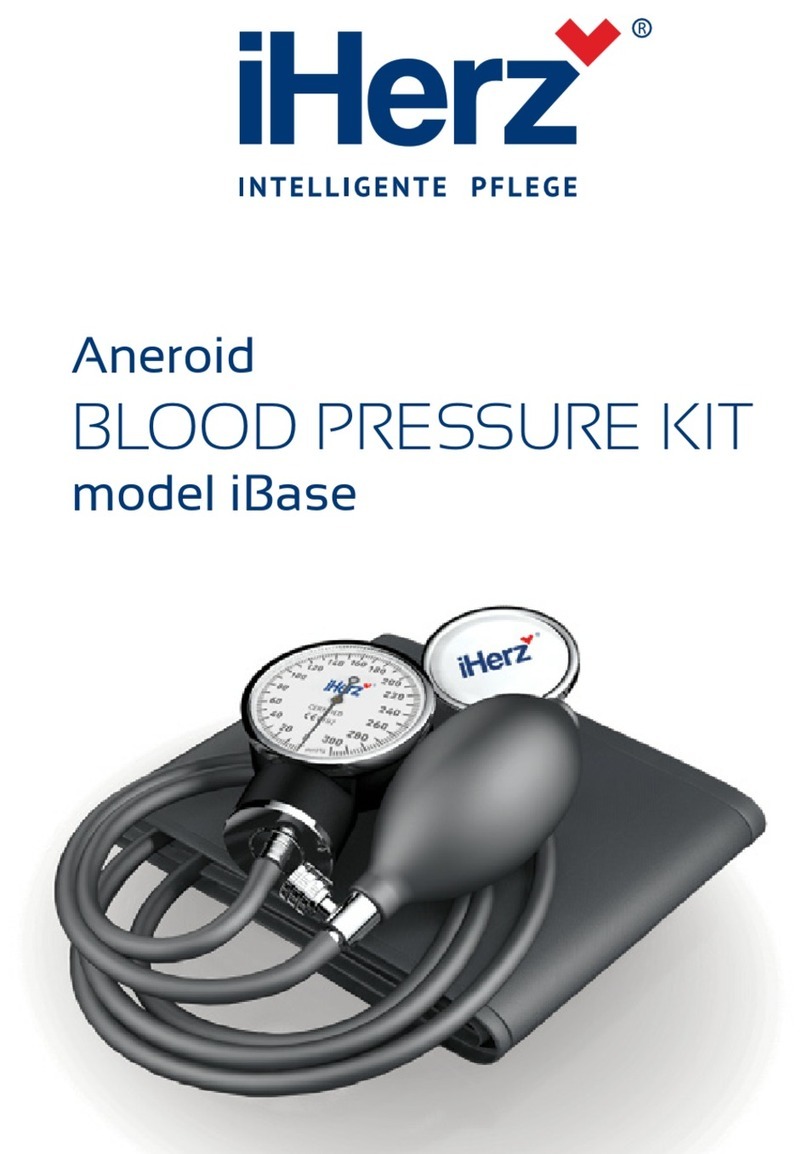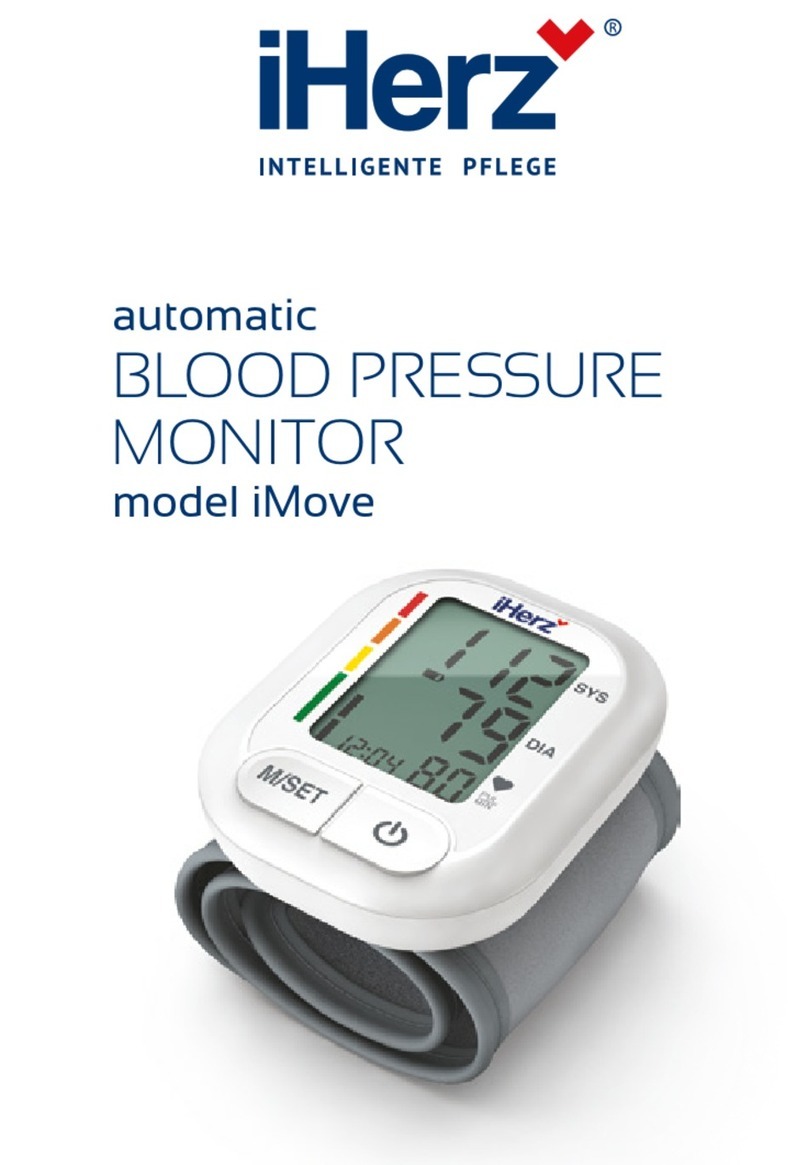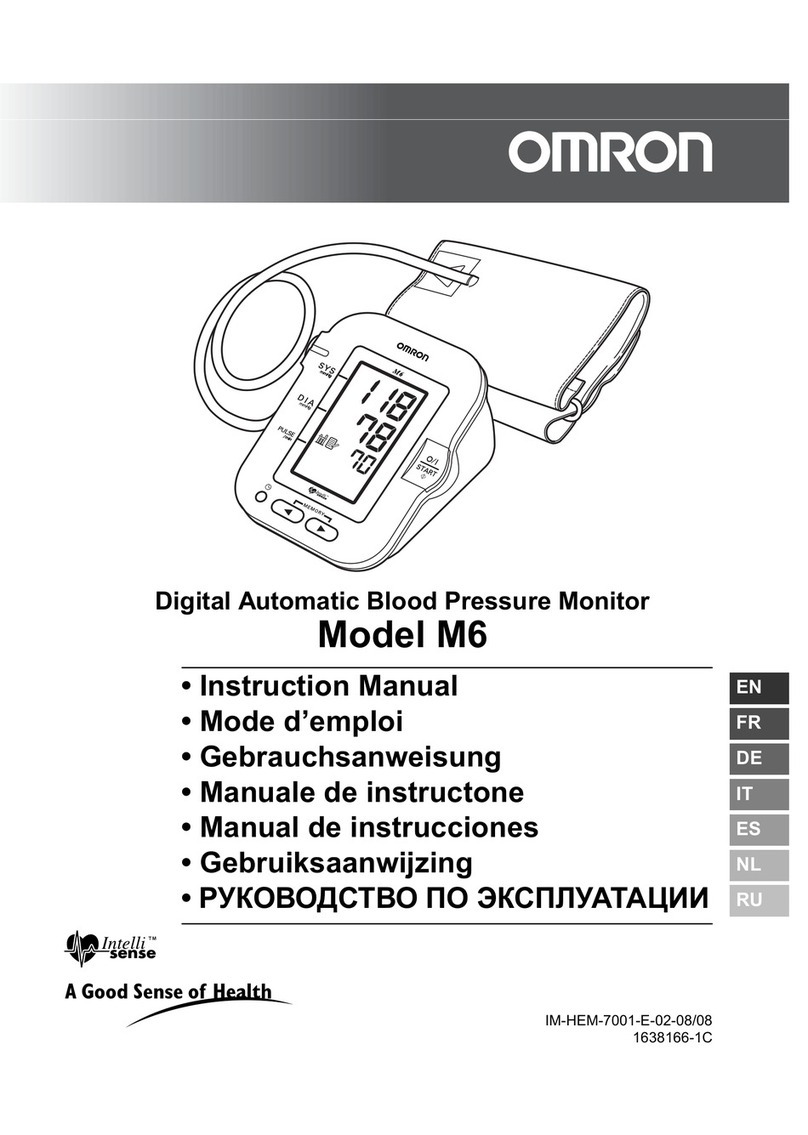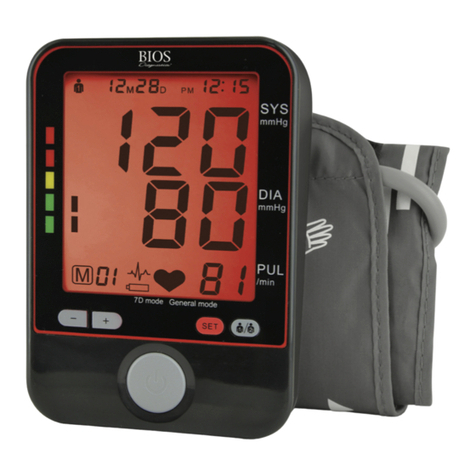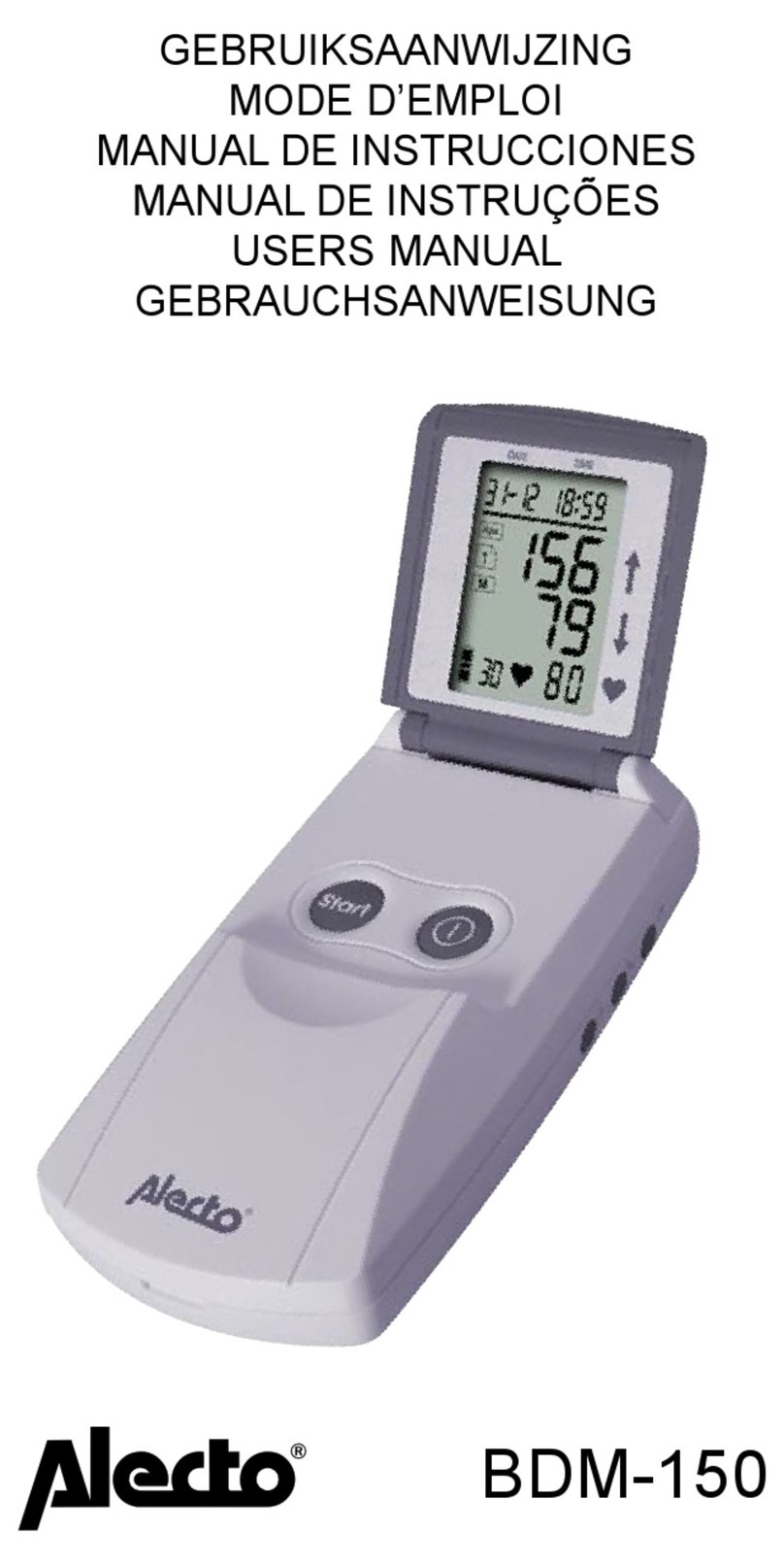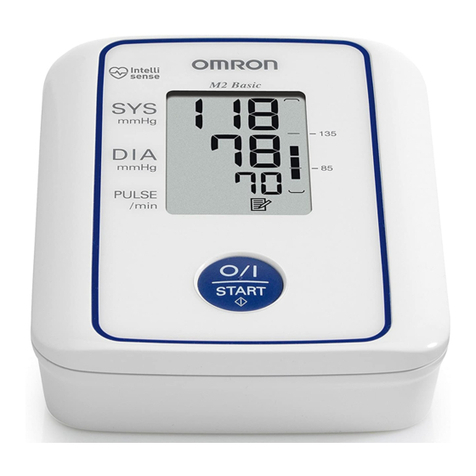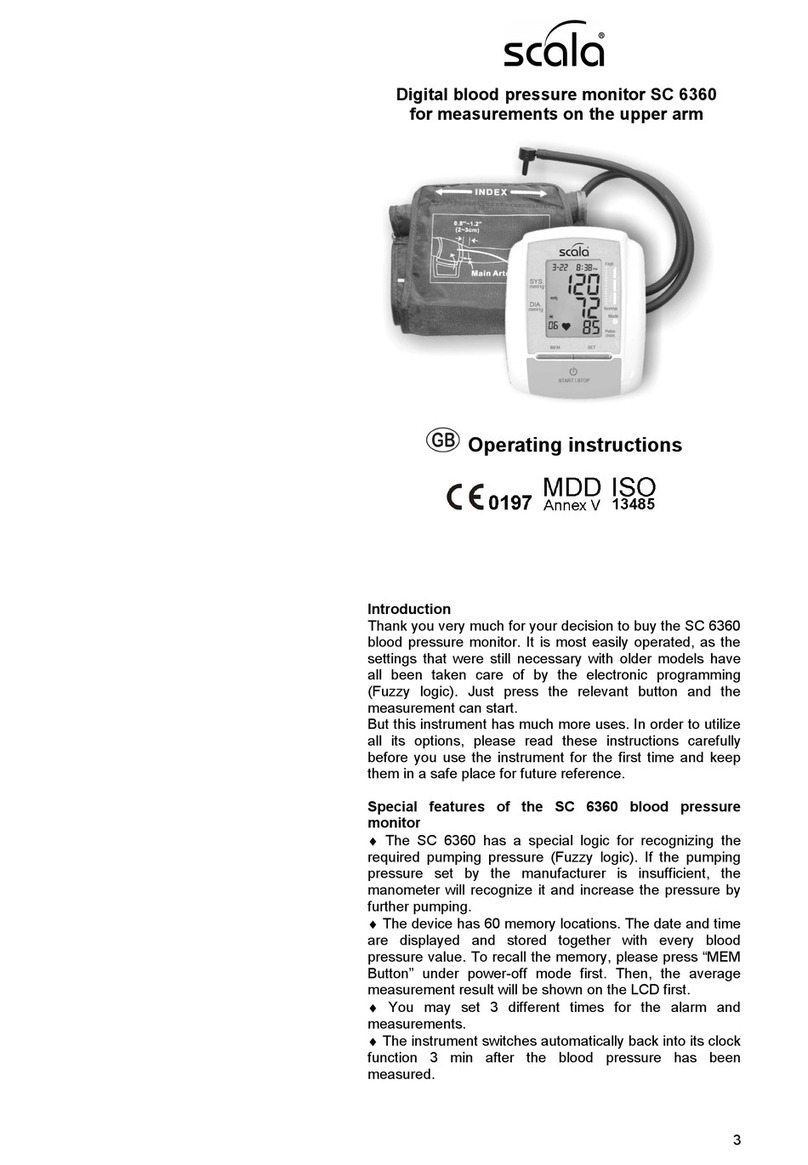iHerz iTop User manual

automatic
BLOOD PRESSURE
MONITOR
model iTop
model
iTop

2
DEAR TM IHERZ®AUTOMATIC BLOOD
PRESSURE MONITOR OWNER
Thank you for choosing Automatic Blood Pressure Monitor TM iHerz® model iTop. We
are sure that having appraised worthily the high quality and reliability of this device you
will become a regular user of the products of Italian Trademark TM iHerz®.
Before starting to use this device, please, study the user’s manual carefully. The user’s
manual oers all information you need to measure your blood pressure and pulse cor-
rectly. For all questions concerning the device, please, contact your local distributor or
TM iHerz®service centre in your country.
ATTENTION
This blood pressure monitor is designed to carry out self-control over blood pressure but
NOT to make self-diagnosis of hypertension/hypotension. Please, DO NOT diagnose by
yourselves basing on the measurement results obtained with the blood pressure moni-
tor. Please, DO NOT execute self-treatment of high/low blood pressure and DO NOT
change the methods prescribed without consulting your doctor.
Type BF applied part.
Read the instructions carefully before using this device.

3
EN
IMPORTANT INFORMATION ON BLOOD
PRESSURE AND ITS MEASUREMENT
What Is Blood Pressure?
Blood pressure is the pressure that your blood extends to
the vascular walls. Blood pressure is necessary to provide
for constant blood ow inside the body. Thanks to it the
cells get oxygen that provides for their normal functioning.
The heart performs the function of a «pump», sending
blood to the blood vessels. Each heart beat creates a
certain level of the blood pressure.
There are 2 kinds of blood pressure: a systolic (upper)
one, which corresponds to the heartbeat pushing blood
into the arteriae; and a diastolic (lower) one, which means the blood pressure between
two heartbeats.
Blood pressure is subject to uctuations during the day even in healthy people. The uc-
tuations are inuenced by a number of factors - time of day, person’s condition, physical
or mental activity, environment, etc.
Day-Night Fluctuations of the Blood Pressure
An increase of blood pressure increases the burden onto the heart, aects blood vessels
making their walls thick and less elastic.
One of the features of the hypertension is its ability to remain unnoticed for the patient
at its early stages. That’s why the self control of the blood pressure is so important. With
the illness progressing, headaches and regular dizziness appear, the sight declines, the
functioning of vitals (encephalon, heart, kidneys, blood vessels) breaks down. Without
special treatment the complications of hypertension might be kidney damages, breast-
pang, paralytic stroke, aphasia, dementia, heart attack and stroke.
Which Values are Normal?
The world standard as for the norms of the blood pressure is the Classication* of the
World Health Organization (WHO):
170
160
150
140
130
120
110
100
90
80
70
60
50
40
8.00 10.00 12.00 14.00 16.00 18.00 20.00 22.00 24.00 2.00 4.00 6.00 8.00
DIA blood pressure
SYS blood pressure
Time (hours)
mmHg

4
Category
Systolic
Blood Pressure
(mmHg)
Diastolic
Blood Pressure
(mmHg)
Blood pressure too low < 100 < 60
Blood pressure optimum 100 - 119 60 - 79
Blood pressure normal 120 - 129 80 - 84
Blood pressure slightly high 130 - 139 85 - 89
Blood pressure too high 140 - 159 90 - 99
Blood pressure far too high 160 - 179 100 - 109
Blood pressure dangerously high ≥ 180 ≥ 110
* Printed with curtailments.
• The diagnosis of hypertension requires from the patient to combine medical treatment
prescribed by the doctor and mode of life correction.
• People with normal pressure and high normal pressure are recommended to carry out
self-control of their tension in order to timely take measures to decrease the blood
pressure level down to the optimal one without using any medications.
• For people more than 50 years old high level of systolic blood pressure (higher than
140 mmHg) is more crucial than diastolic pressure.
• Even with blood pressure being normal, people run the bigger risk of hypertension
development with advancing age.
ATTENTION
If you have normal results of blood pressure measured under calm conditions but your
results are excessively high when measured under the conditions of physical or mental
exhaustion, this might be a sign of so called brittle (that is unstable) hypertension. If you
suspect that, please, consult your doctor.
When measured correctly, if diastolic blood pressure is more than 120 mmHg, it is necessary
to call the doctor immediately.
ADVANTAGES OF AUTOMATIC
BLOOD PRESSURE MONITOR
MODEL ITOP
Blood Pressure Rate Indicator
Blood pressure rate indicator is located along left side of the display. The classication
corresponds to 6 ranges described in the table of the section «Which values are nor-
mal?». After the measurement there appears the dotted line in the left part of the display
opposite the zone to which the result of the measurement corresponds: green zone -

5
EN
optimal blood pressure, yellow - elevated, orange - too high, red - dangerously high. This
function helps you to self-orient in the measurement results.
Irregular Heartbeat Detection Technology
An irregular heartbeat is detected when a heartbeat rhythm varies while the unit is meas-
uring the systolic and diastolic blood pressure.During each measurement, the monitor
records all the pulse intervals and calculate the average ; if there are two or more pulse
intervals ,the dierence between each interval and the average is more than the average
value of ±25% , or there are four or more pulse intervals ,the dierence between each
interval and the average is more than the average value of ±15%,the irregular heartbeat
symbol appears on the display when the measurement results are appear.
Multiple Users
2 users can make measurements and store data together. Memory allows up to 60
results for each user enabling to display average results, which include quite long period
of time. There is no need to write down and store the results on hard copies every time
after measurement.
GETTING READY FOR MEASUREMENT
Safety Precautions
* This device is intended for adult use in homes only.
* The device is not suitable for use on neonatal patients, pregnant women,patients with
implanted, electronical devices, patients with pre-eclampsia, premature ventricular
beats, atrial brillation, peripheral, arterial disease and patients undergoing intravascular
therapy or arterio-venous shunt or people who received a mastectomy. Please consult
your doctor prior to using the unit if you suer from illnesses.
* The device is not suitable for measuring the blood pressure of children. Ask your doctor
before using it on older children.
* The device is not intended for patient transport outside a healthcare facility.
* The device is not intended for public use.
* This device is intended for no-invasive measuring and monitoring of arterial blood pressure.
It is not intended for use on extremities other than the arm or for functions other than
obtaining a blood pressure measurement.
* Do not confuse self-monitoring with self-diagnosis. This unit allows you to monitor your blood
pressure.Do not begin or end medical treatment without asking a physician for treatment advice.
* If you are taking medication,consult your physician to determine the most appropriate
time to measure your blood pressure. Never change a prescribed medication without
consulting your physician.
* Do not take any therapeutic measures on the basis of a self measurement. Never alter
the dose of a medicine prescribed by a doctor. Consult your doctor if you have any ques-
tion about your blood pressure.
* When the device was used to measure patients who have common arrhythmias such
as atrial or ventricular premature beats or atrial brillation, the best result may occur with

6
deviation. Please consult your physician about the result.
* Don’t kink the connection tube during use, otherwise, the cu pressure may continu-
ously increase which can prevent blood ow and result in harmful injury to the PATIENT.
* When using this device, please pay attention to the following situation which may inter-
rupt blood ow and inuence blood circulation of the patient, thus cause harmful injury
to the patient: connection tubing kinking too frequent and consecutive multiple measure-
ments; the application of the cu and its pressurization on any arm where intravascular
access or therapy, or an arterio-venous (A-V) shunt, is present; inating the cu on the
side of a mastectomy.
* Warning: Do not apply the cu over a wound;otherwise it can cause further injury.
*Do not inate the cu on the same limb which other monitoring ME equipment is applied
around simultaneously, because this could cause temporary loss of function of those
simultaneously-used monitoring ME equipment.
*On the rare occasion of a fault causing the cu to remain fully inated during measure-
ment, open the cu immediately. Prolonged high pressure (cu pressure >300mmHg
or constant pressure > 15mmHg for more than 3 minutes) applied to the arm may lead
to an ecchymosis.
*Please check that operation of the device does not result in prolonged impairment of
patient blood circulation.
* When measurement, please avoid compression or restriction of the connection tubing.
* The device cannot be used with HF surgical equipment at the same time.
* The ACCOMPANYING DOCUMENT shall disclose that the SPHYGMOMANOMETER
was clinically investigated according to the requirements of ISO 81060-2:2013.
* To verify the calibration of the AUTOMATED SPHYGMOMANOMETER, please contact
the manufacturer.
* This device is contraindicated for any female who may be suspected of, or is pregnant.
Besides providing inaccurate readings, the eects of this device on the fetus are unknown.
* Too frequent and consecutive measurements could cause disturbances in blood
circulation and injuries.
* This unit is not suitable for continuous monitoring during medical emergencies or op-
erations. Otherwise, the patient’s arm and ngers will become anaesthetic, swollen and
even purple due to a lack of blood.
* When not in use, store the device in a dry room and protect it against extreme moisture,
heat, lint, dust and direct sunlight. Never place any heavy objects on the storage case.
* This device may be used only for the purpose described in this booklet. The manufac-
turer cannot be held liable for damage caused by incorrect application.
*This device comprises sensitive components and must be treated with caution.
Observe the storage and operating conditions described in this booklet.
* The equipment is not AP/APG equipment and not suitable for use in the presence of a
ammable anesthetic mixture with air of with oxygen or nitrous oxide.
* Warning: No servicing/maintenance while the ME equipment is in use.
* The patient is an intended operator.
* The patient can measure data and change batteries under normal circumstances and
maintain the device and its accessories according to the user manual.
* To avoid measurement errors, please avoid the condition of strong electromagnetic
eld radiated interference signal or electrical fast transient/burst signal.
* The blood pressure monitor and the cu are suitable for use within the patient environ-
ment. If you are allergic to polyester, nylon or plastic, please don’t use this device.
* During use, the patient will be in contact with the cu. The materials of the cu have

7
EN
been tested and found to comply with requirements of ISO 10993-5:2009 and ISO
10993-10:2010. It will not cause any potential sensization or irritation reaction.
* If you experience discomfort during a measurement, such as pain in the arm or other
complaints, press the START/STOP button to release the air immediately from the cu.
Loosen the cu and remove it from your arm.
* If the cu pressure reaches 40 kPa (300 mmHg), the unit will automatically deate.
Should the cu not deate when pressures reaches 40 kPa (300 mmHg), detach the cu
from the arm and press the START/STOP button to stop ination.
* Before use, make sure the device functions safely and is in proper working condition.
Check the device, do not use the device if it is damaged in any way. The continuous use
of a damaged unit may cause injury, improper results, or serious danger.
* Do not wash the cu in a washing machine or dishwasher!
* The service life of the cu may vary by the frequency of washing, skin condition, and
storage state. The typical service life is 10000 times.
* It is recommended that the performance should be checked every 2 years and after
maintenance and repair, by retesting at least the requirements in limits of the error of
the cu pressure indication and air leakage (testing at least at 50mmHg and 200mmHg).
* Please dispose of ACCESSORIES, detachable parts, and the ME EQUIPMENT ac-
cording to the local guidelines.
* Manufacturer will make available on request circuit diagrams, component part lists,
descriptions, calibration instructions,etc., to assist to service personnel in parts repair.
* The operator shall not touch output of batteries and the patient simultaneously.
* Cleaning :Dust environment may aect the performance of the unit. Please use the soft
cloth to clean the whole unit before and after use. Don’t use any abrasive or volatile cleaners.
* The device doesn’t need to be calibrated within two years of reliable service.
* If you have any problems with this device, such as setting up, maintaining or using,
please contact the SERVICE PERSONNEL of Transtek. Don’t open or repair the device
by yourself in the event of malfunctions. The device must only be serviced, repaired and
opened by individuals at authorized sales/service centers.
* Please report to Transtek if any unexpected operation or events occur.
* Keep the unit out of reach of infants, young children or pets to avoid inhalation or swal-
lowing of small parts. It is dangerous or even fatal.
* Be careful to strangulation due to cables and hoses, particularly due to excessive length.
* At least 30 min required for ME equipment to warm from the minimum storage tem-
perature between uses until it is ready for intended use. At least 30 min required for ME
equipment to cool from the maximum storage temperature between uses until it is ready
for intended use.
* This equipment needs to be installed and put into service in accordance with the infor-
mation provided in the ACCOMPANYING DOCUMENTS;
* Wireless communications equipment such as wireless home network devices, mobile
phones, cordless telephones and their base stations, walkie-talkies can aect this equip-
ment and should be kept at least a distance d away from the equipment. The distance
d is caculated by the MANUFACTURER from the 80MHz to 5.8 GHz column of Table 4
and Table 9 of IEC 60601-1-2:2014, as appropriate.
* Please use ACCESSORIES and detachable partes specied/ authorised by MANU-
FACTURE. Otherwise, it may cause damage to the unit or danger to the user/patients.
* There is no luer lock connectors are used in the construction of tubing, there is a pos-
sibility that they might be inadvertently connected to intravascular uid systems, allowing
air to be pumped into a blood vessel.

8
* Please use the device under the environment which was provided in the user manual.
Otherwise, the performance and lifetime of the device will be impacted and reduced.
KEEP THIS MANUAL DURING THE WHOLE LIFETIME OF THE DEVICE
Components of Your Blood Pressure Monitor Kit
The blood pressure monitor kit includes Automatic Blood Pressure Monitor model
iTop, 22 - 32 cm cu, 4 batteries 1,5 V (AAA), user’s manual, warranty card, kit box.
Description of the Blood Pressure Monitor
1. AIR CONNECTOR PLUG
2. LCD DISPLAY
3. MEM BUTTON
4. SET BUTTON
5. START/STOP BUTTON
6. CUFF
7. AIR HOSE
8. BATTERY COMPARTMENT
Installing and Replacing the Batteries
• Open the battery cover.
• Install the batteries as indicated in the battery
compartment.
(Always select the authorized / specied
battery: Four AAA-size alkaline batteries).
• Replace the battery cover.
Replace the batteries whenever the below
happen
• The shows
• The display is dim
• The display does not light up
2
4
3
7
8
6
1
5
9

9
EN
LCD display signal
SYMBOL DESCRIPTION EXPLANATION
Systolic blood pressure High blood pressure
Diastolic blood pressure Low blood pressure
Pulse display Pulse in beats per minute
Average value The average value of blood pressure
Memory Indicate it is in the memory mode and
which group of memory it is.
Motion indicator Motion may result in an inaccurate
measurement
mmHg Measurement Unit of the blood pres-
sure
Low battery Batteries are low and need to be
replaced
Irregular heartbeat Blood pressure monitor is detecting
an irregular heartbeat during meas-
urement.
Blood pressure
level indicator
Indicate the blood pressure level
Current Time Year/Month/Day, Hour/Minute
Heartbeat Blood pressure monitor is detecting a
heartbeat during measurement.
User 1 Start measurement for User 1
User 2 Start measurement for User 2

10
Setting the Date and Time
It is important to set the clock before using your blood pressure monitor, so that a time
stamp can be assigned to each record that is stored in the memory. (The setting range
of the year :2019—2057 time format:12 H/24H)
1. When the monitor is o, hold pressing “USER” for 3 seconds to enter the mode for
year setting. Or when the monitor is o, press “USER” button shortly, it will display the
time. Then hold pressing “USER” button to enter the mode for year setting.
2. Press the “MEM” to change the [YEAR]. Each press will increase the numeral by one
in a cycling manner.
3. When you get the right year, press “SET” to set down and turn to next step.Repeat
steps 2 and 3 to set the [MONTH] and [DAY].
4. Repeat steps 2 and 3 to conrm the time format [12H] and [24h].
5. Repeat steps 2 and 3 to set the [HOUR] and [MINUTE].
6. Repeat steps 2 and 3 to set the [UNIT].
7. After the unit is set,the LCD will display “donE”rst,then display all the settings you
have done and then it will turn o.
MEASUREMENT PROCEDURE
ATTENTION
• Find time to relax by sitting in a quiet atmosphere for some time before measurement.
• Be seated with your feet at on the oor, and don’t cross your legs. Place palm upside
in front of you on a at surface such as desk or table. The middle of the cu should be
at the level of the right atrium of the heart.
• Eorts by the patient to support the arm can increase the blood pressure. Make sure
you are in a comfortable, relaxed position and do not activate any muscles in the arm
during measurement.

11
EN
• Always measure on the same arm (normally left).
• Remove any garment that ts closely to your upper arm. Do not roll the sleeve since
it can squeeze your hand and this can lead to false results.
• Use only clinically approved original cu.
• If you want to follow the results of your blood pressure measurements, always per-
form measurements at the same time of day, since blood pressure changes during
the course of the day.
• Measurements should be done after a 5 minute rest to ensure accuracy.
Fitting the Cu
Select a pressure cu size that corresponds to the circumference
of your shoulder (measured with a tight t in the middle of the
shoulder). The size M (22-32 cm) is a size tting the majority
of people.
1. Remove all jewelry, such as watches and bracelets from
your left arm.Note: If your doctor has diagnosed you with poor
circulation in your left arm, use your right arm.
2. Roll or push up your sleeve to expose the skin. Make sure
your sleeve is not too tight.
3. Hold your arm with your palm facing up and tie the cu on
your upper arm, then position the tube o-center toward the
inner side of arm in line with the little nger. Or position the artery
mark over the main artery (on the inside of your arm).
Note: Locate the main artery by pressing with 2 ngers
approximately 2 cm above the bend of your elbow on the
inside of your left arm. Identify where the pulse can be felt the
strongest. This is your main artery.
4. The cu should be snug but not too tight. You should be able
to insert one nger between the cu and your arm.
5. Sit comfortably with your tested arm resting on a at surface. Place your elbow on
a table so that the cu is at the same level as your heart. Turn your palm upwards. Sit
upright in a chair, and take 5-6 deep breaths.
6. Helpful tips for Patients, especially for Patients with Hypertension:
• Rest for 5 minutes before rst measuring.
• Wait at least 3 minutes between measurements.
• This allows your blood circulation to recover.
• Take the measurement in a silent room.
• The patient must relax as much as possible and do not move and talk during the
measurement procedure.
• The cu should maintain at the same level as the right atrium of the heart.
• Please sit comfortably. Do not cross your legs and keep your feet at on the ground.
• Keep your back against the backrest of the chair.
• For a meaningful comparison, try to measure under similar conditions. For example,
take daily measurements at approximately the same time, on the same arm, or as di-
rected by a physician.
2-3 cm
Arm cu

12
Measuring Procedure
When the monitor is o, press the “START/STOP” to turn on the monitor, and it will nish
the whole measurement .(Take User 1 for example)
LCD display Adjust the zero Inating and measuring Display and save
the results.
Press the “START/STOP” to power o, otherwise it will turn o
within 1 minute.
MEMORY FUNCTION
Reading Measurement Results
1. When the monitor is o, please press the “MEM” to show the
average value of the latest three records.If the records are
less than three groups,it will display the latest record rst.
2. Press the “MEM” or “SET” to get the record you want.
The date and time of the record will be
shown alternately.
CAUTION
The most recent record (1) is shown rst. Each new measurement is assigned to the rst
(1) record. All other records are pushed back one digit (e.g., 2 becomes 3, and so on),
and the last record (60) is dropped
The current No. is No 2.T he corresponding
time is P.M. 10:08.
The corresponding
date is January 1st.

13
EN
Delete Memories
If you did not get the correct measurement, you can delete all
results by following steps below.
1. Hold pressing “MEM” for 3 seconds when the monitor is in the
memory recall mode ,the ash display will show.
2. Press “SET” to conrm deleting and the monitor will turn o.
3. If you don’t want to delete the records, press “START/STOP” to
escape.
4. If there is no record, the right display will show.
ERROR MESSAGES/ TROUBLESHOOTING
This section includes a list of error messages and frequently asked questions for prob-
lems you may encounter with your blood pressure monitor. If the products not operating
as you think it should, check here before arranging for servicing.
PROBLEM SYMPTOM CHECK THIS REMEDY
No power
Display will not
light up.
Batteries are exhausted. Replace with new
batteries
Batteries are inserted
incorrectly.
Insert the batteries correctly
Low batteries Display is dim
or show
Batteries are low. Replace with new
batteries
Error message
E 01 shows The cu is too tight or too
loose.
Readjust the cu ,not too
loose or too tight and then
measure again.
E 02 shows The monitor detected
motion,talking or the
pluse is too poor while
measuring.
Relax for a moment and then
measure again.
E 03 shows The measurement process
does not detect the pulse
signal.
Loosen the clothing on the
arm and then measure again
E 04 shows The treatment of the
measurement failed.
Relax for a moment and then
measure again.
EExx,shows on
the display.
A calibration error
occurred.
Retake the measurement. If
the problem persists, contact
the retailer or our customer
service department for further
assistance.Refer to the war-
ranty for contact information
and return

14
Warning
message
“out ” shows Out of measurement
range
Relax for a moment. Refasten
the cu and then measure
again. If the problem persists,
contact your physician.
The functionality of this device may be disturbed by the use of strong electromagnetic
elds such as mobile phones or radio stations at close range, so we recommend that
these devices be kept at least 1 m away. In cases where this is inevitable, please make
sure that the device is working properly before use. If you are suering from a heartbeat
disorder (arrhythmia), evaluation of measurement results of the device can be given only
after consultation with a physician.
CARE AND MAINTENANCE
In order to get the best performance, please follow the instructions below.
Put in a dry place and avoid the sunshine
Avoid touching water, clean it with a dry cloth in case.
Avoid intense shaking and collisions
Avoid dusty and unstable temperature environment
Using wet cloths to remove dirt
Do not attempt to clean the reusable cu with water
and never immerse the cu in water.

15
EN
Disinfection: If required (for example, in a hospital setting), disinfection of the pressure
cu twice per week is recommended.
Disinfect the interior of the pressure cu (the surfaces that come into contact with the
patient’s skin) with the use of a soft cloth soaked in ethyl alcohol (75-90%) and wait for
the pressure cu to dry up.
Cleaning of the pressure cu after 200 uses is recommended.
Periodic calibration of device: the accuracy of measurement instruments must be ver-
ied from time to time. For this reason, verication of the indication of statistical pressure
periodically (once a year) and after technical maintenance and repair is recommended.
More information can be obtained from the service center.
SYMBOL INFORMATION
SYMBOL REFERENT
Consult instruction for use
Manufacturer
Manufacturing date
Serial number
Direct current
Caution, consult accompanying documents
Dispose of in accordance with the requirements
of your country
The cu is type BF applied part
European representative
CE mark
Recycle
The Green Dot is the license symbol of a European network of
industry-funded systems for recycling the packaging materials
of consumer goods.
TECHNICAL SPECIFICATIONS

16
Power supply Battery powered mode:
6VDC 4*AAA alkaline batteries
Display mode Blue LCD with white backlight V.A.60mm×40.5mm
Measurement mode Oscillographic testing mode
Measurement range
Rated cu pressure:
0mmHg~299mmHg(0kPa ~ 39.9kPa)
Measurement pressure: SYS: 60mmHg~230mmHg
(8.0kPa~30.7kPa) DIA: 40mmHg~130mmHg
(5.3kPa~17.3kPa) Pulse value: (40-199)beat/minute
Accuracy Pressure: 5°С-40°Сwithin±0.4kPa(3mmHg)
Pulse value: ±5%
Normal working condition A temperature range of :+5°C to +40°C
A relative humidity range of 15% to 90%,
non-condensing, but not requiring a water vapour
partial pressure greater than 50 hPa An atmospher-
ic pressure range of : 700 hPa to 1060 hPa
Storage & transportation
condition
Temperature:-20°C to +60°C
A relative humidity range of ≤ 93%, non-condens-
ing, at a water vapour pressure up to 50hPa
Measurement perimeter of
the upper arm
About 22cm~32cm or 22cm~42cm
Net Weight Approx.182g(Excluding the dry cells)
External dimensions Approx.110mm×110mm×41mm
Attachment 4×AAA alkaline batteries,user manual
Mode of operation Continuous operation
Degree of protection Type BF applied part
Protection against ingress
of water
IP21 It means the device could protected against
solid foreign objects of 12.5mm and greater, and
protect against vertcally falling water drops.
Device Classication Battery Powered Mode:
Internally Powered ME Equipment
WARNING: No modication of this equipment is allowed.
Conformance to standards: DSTU EN 1060-1:2015 “Non-Invasive Sphygmomanometer.”
General Requirements. Paragraph 9.2. DSTU EN 1060-3:2015 “Non-Invasive
Sphygmomanometer.” Part 3. Paragraph 9.2.
WARRANTY
Your Automatic Blood Pressure Monitor Model iTop is warranted for 5 years from

17
EN
date of purchase. Warranty for the cuff is 1 year from the date of purchase. The
warranty does not apply to batteries and damage caused by improper handling,
accidents, not following the operating instructions or self-maintained alterations
made to the device. The warranty is only valid upon presentation of the warranty
card with purchase date and stamp of trade organization.
COMPLIED STANDARDS LIST
Risk management EN ISO 14971:2012 / ISO 14971:2007 Medical devices
-Application of risk management to medical devices
Labeling EN ISO 15223-1:2016 / ISO 15223-1:2016 Medical
devices. Symbols to be used with medical device labels,
labelling and information to be supplied. Part 1 : General
requirements
User manual EN 1041:2008 Information supplied by the manufacturer of
medical devices
General Requirements for Safety EN 60601-1:2006+A1:2013/ IEC 60601-1:2005+A1:2012
Medical electrical equipment - Part 1: General requirements
for basic safety and essential performance
EN 60601-1-11:2015/ IEC 60601-1-11:2015 Medical
electrical equipment - Part 1-11: General requirements
for basic safety and essential performance - Collateral
standard: Requirements for medical electrical equipment
and medical electrical systems used in the home healthcare
environment
Electromagnetic compatibility EN 60601-1-2:2015/ IEC 60601-1-2:2014 Medical electrical
equipment - Part 1-2: General requirements for basic safety
and essential performance - Collateral standard: Electro-
magnetic disturbances - Requirements and tests
Performance requirements EN ISO 81060-1:2012 Non-invasive sphygmomanometers
- Part 1: Requirements and test methods for non-automated
measurement type
EN 1060-3:1997+A2:2009 Non-invasive sphygmomanom-
eters - Part 3: Supplementary requirements for electro-
mechanical blood pressure measuring systems
IEC 80601-2-30:2009+A1:2013 Medical electrical equip-
ment- Part 2-30: Particular requirements for the basic
safety and essential performance of automated non-
invasive sphygmomanometers
Clinical investigation EN 1060-4:2004 Non-invasive sphygmomanometers - Part
4: Test procedures to determine the overall system accu-
racy of automated non-invasive sphygmomanometers
ISO 81060-2:2013 Non-invasive sphygmomanometers -
Part 2:Clinical validation of automated measurement type

18
Usability EN 60601-1-6:2010+A1:2015/IEC 60601-1-
6:2010+A1:2013 Medical electrical equipment - Part 1-6:
General requirements for basic safety and essential perfor-
mance - Collateral standard: Usability
IEC 62366-1:2015 Medical devices - Part 1: Application of
usability engineering to medical devices
Software life-cycle processes EN 62304:2006/AC: 2008 / IEC 62304: 2006+A1:2015
Medical device software - Software life-cycle processes
Bio-compatibility ISO 10993-1:2009 Biological evaluation of medical devices-
Part
1: Evaluation and testing within a risk management process
ISO 10993-5:2009 Biological evaluation of medical devices
-
Part 5: Tests for in vitro cytotoxicity
ISO 10993-10:2010 Biological evaluation of medical
devices -
Part 10: Tests for irritation and skin sensitization
EMC Guidance
1) This product needs special precautions regarding EMC and needs to be in-
stalled and put into service according to the EMC information provided, and this
unit can be affected by portable and mobile RF communications equipment.
2) Do not use a mobile phone or other devices that emit electromagnetic fields,
near the unit. This may result in incorrect operation of the unit.
3) Caution: This unit has been thoroughly tested and inspected to assure proper
performance and operation!
4) Caution: This machine should not be used adjacent to or stacked with other
equipment and that if adjacent or stacked use is necessary, this machine should
be observed to verify normal operation in the configuration in which it will be used.
Table 1
Guidance and manufacturer’s declaration – electromagnetic emissions
The device is intended for use in the electromagnetic environment specied below. The customer or
the user of the device should assure that it is used in such an environment.
Emissions test Compliance Electromagnetic environment - guidance
RF emissions
CISPR 11
Group 1 The device uses RF energy only for its internal
function. Therefore, its RF emissions are very
low and are not likely to cause any interference in
nearby electronic equipment.
RF emissions
CISPR 11
Class B The device is suitable for use in all establishments,
other than domestic and those directly connected
to the public low-voltage power supply network that
supplies buildings used for domestic purposes.
Harmonic emissions
IEC 61000-3-2
Class A
Voltage uctuations/
icker emissions
IEC 61000-3-3
Complies

19
EN
Table 2
Guidance and manufacturer’s declaration – electromagnetic immunity
The device is intended for use in the electromagnetic environment specied below. The customer or
the user of the device should assure that it is used in such an environment.
Immunity test IEC 60601 test level Compliance level
Electromagnetic
environment - guidance
Electrostatic dis-
charge (ESD)
IEC 61000-4-2
±8 kV contact
±15 kV air
±8 kV contact
±15 kV air
Floors should be wood,
concrete or ceramic tile.
If oors are covered with
synthetic material, the
relative humidity should be
at least 30%.
Electrical fast
transient/burst
IEC 61000-4-4
power supply lines:
±2 kV
input/output lines:
±1 kV
power supply lines:
±2 kV
Mains power quality
should be
that of a typical com-
mercial or
hospital environment.
Surge
IEC61000-4-5
line(s) to line(s):
±1 kV
line(s) to earth: ±2 kV
100 kHz repetition
frequency
line(s) to line(s): ±1 kV
100 kHz repetition
frequency
Mains power quality
should be that of a typical
commercial or hospital
environment.
Voltage dips,
short interrup-
tions and voltage
variations on
power supply
input lines
IEC 61000-4-11
0%UT; 0.5 cycle
At 0°, 45°, 90°, 135°,
180°,225°,270° and
315° 0%UT ; 1 cycle
and 70%UT ; 25/30
cycles Single phase:
at 0° 0% UT ; 300
cycle
0% UT ; 0.5 cycle
At 0°, 45°, 90°, 135°,
180°,225°,270° and
315° 0% UT ; 1 cycle
and
70% UT ; 25/30 cycles
Single phase: at 0°
0% UT ;300 cycle
Mains power quality
should be
that of a typical com-
mercial or
hospital environment.
Power frequency
(50Hz/60Hz)
magnetic eld
IEC 61000-4-8
30 A/m
50Hz/60Hz
30 A/m
50Hz/60Hz
Power frequency mag-
netic elds should be at
levels characteristic of a
typical location in a typical
commercial or hospital
environment.
NOTE UT is the a.c. mains voltage prior to application of the test level.
Table 3
Guidance and manufacturer’s declaration – electromagnetic immunity
The device is intended for use in the electromagnetic environment specied below. The customer or
the user of the device should assure that it is used in such an environment.
Immunity test IEC 60601 test
level
Compliance
level
Electromagnetic
environment - guidance

20
Conducted RF
IEC 61000-4-6
150 kHz to
80 MHz:
3 Vrms
6Vrms (in ISM
and amateur
radio bands)
80% Am at 1kHz
150 kHz to
80 MHz:
3 Vrms
6Vrms (in ISM
and amateur
radio bands)
80% Am at
1kHz
Portable and mobile RF communica-
tions equipment should be used no
closer to any part of the device, includ-
ing cables, than the recommended
separation distance calculated from the
equation appropriate for the frequency
of the transmitter.
Recommended separation distances:
d=0.35
P
;
d=1.2
P
Radiated RF
IEC 61000-4-3
10V/m, 80% Am
at 1kHz
10V/m, 80%
Am
at 1kHz
80 MHz to
800 MHz:
d=1.2
P
800 MHz
to 2.7
GHz:
d=2.3
P
where, P is the maximum
output power rating of the
transmitter in watts (W)
according to the transmit-
ter manufacturer, d is the
recommended separation
distance in meters (m).
Field strengths from
xed RF transmitters, as
determined by an elec-
tromagnetic site survey,
should be less than the
compliance level in each
frequency range.
Interference may occur in
the vicinity of equipment
marked with the following
symbol:
NOTE 1 At 80 MHz and 800 MHz, the higher frequency range applies.
NOTE 2 These guidelines may not apply in all situations. Electromagnetic propagation is aected
by absorption and reection from structures, objects and people.
a Field strengths from xed transmitters, such as base stations for radio (cellular / cordless)
telephones and land mobile radios, amateur radio, AM and FM radio broadcast and TV broadcast
cannot be predicted theoretically with accuracy. To assess the electromagnetic environment due
to xed RF transmitters, an electromagnetic site survey should be considered. If the measured
eld strength in the location in which the device is used exceeds the applicable RF compliance
level above, the device should be observed to verify normal operation. If abnormal performance is
observed, additional measures may be necessary, such as re-orienting or relocating the device.
b Over the frequency range 150 kHz to 80 MHz, eld strengths should be less than 3V/m.
Table 4
Recommended separation distances between portable and mobile RF
communications equipment and the device.
The device is intended for use in an electromagnetic environment in which radiated RF distur-
bances are controlled. The customer or the user of the device can help prevent electromagnetic
interference by maintaining a minimum distance between portable and mobile RF communications
equipment (transmittters) and the device as recommended below, according to the maximum
output power of the communications equipment.
Table of contents
Other iHerz Blood Pressure Monitor manuals
Popular Blood Pressure Monitor manuals by other brands

HoMedics
HoMedics Walgreens BPA-450WGN manual

Dr.Frei
Dr.Frei A-30 user manual
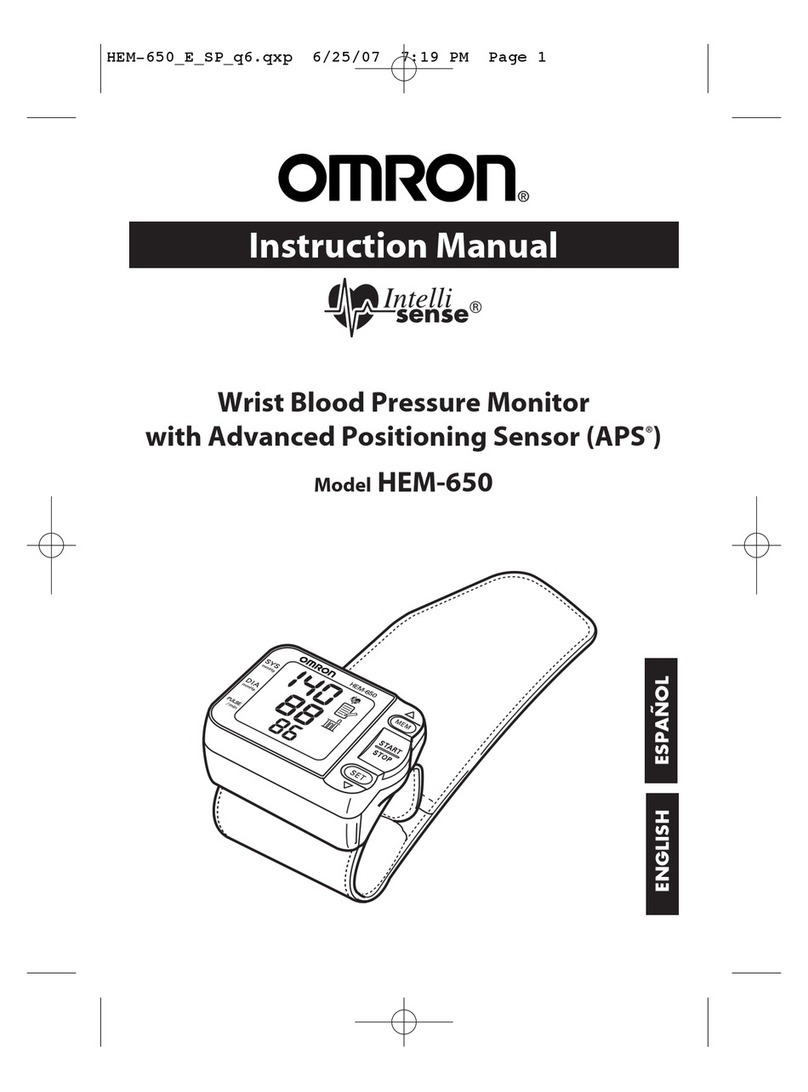
Omron
Omron IntelliSense HEM-650 instruction manual

A&D
A&D UA-1010 instruction manual

Hangzhou Hua'an Medical & Health Instruments
Hangzhou Hua'an Medical & Health Instruments MW-300C Operation guide
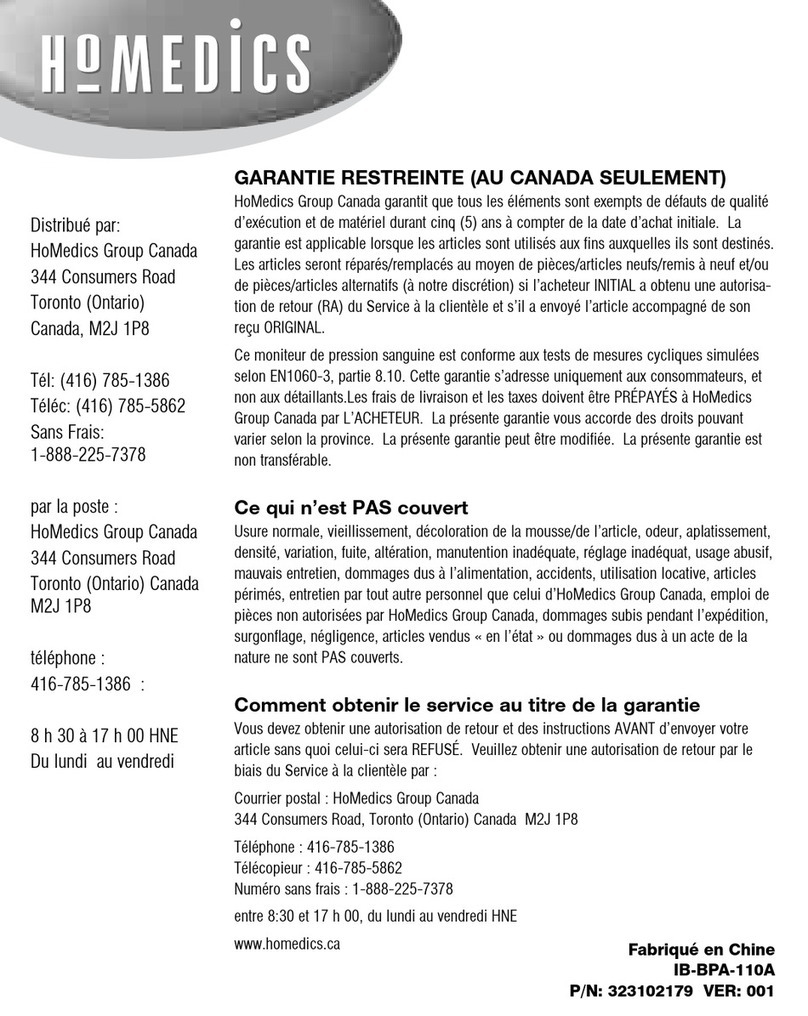
HoMedics
HoMedics BP-A11-02CA Instruction manual and warranty information

